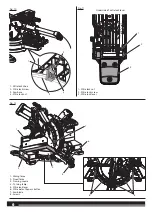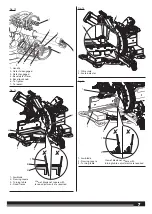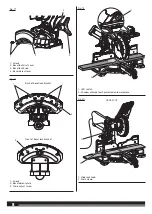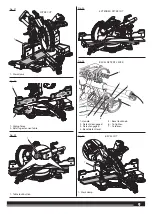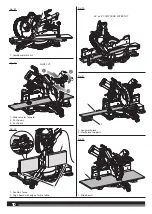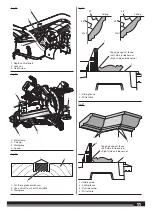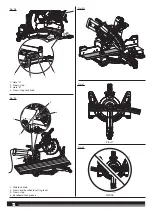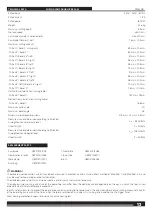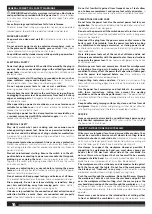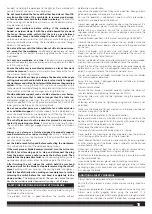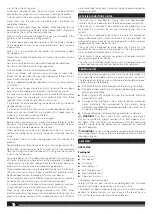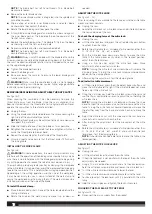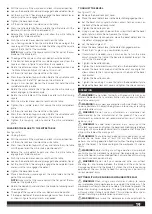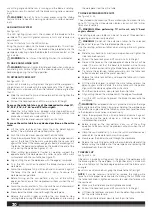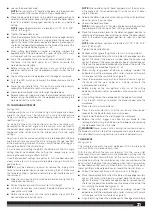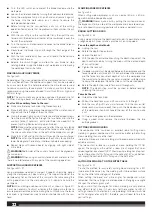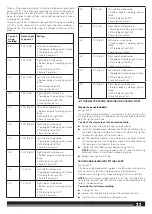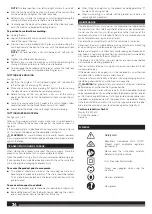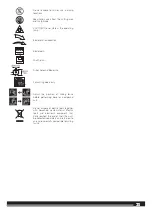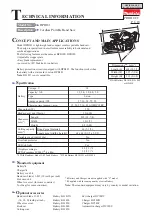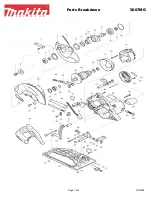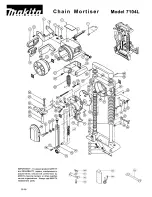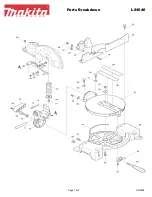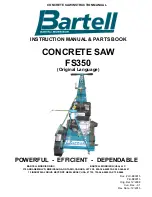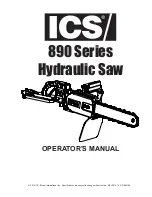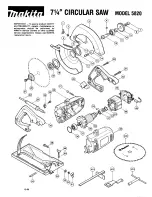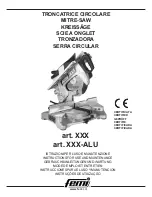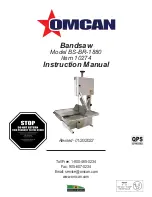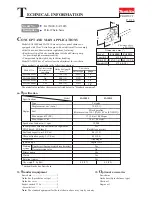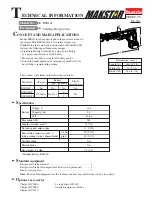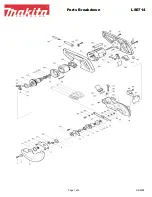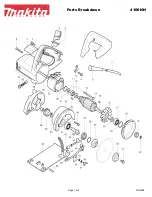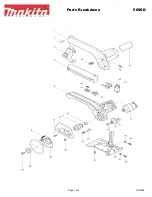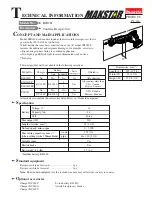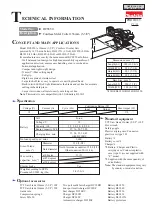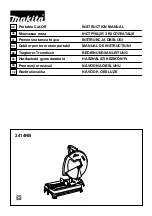
20
20
any cutting angle while the saw is running and the blade is rotating.
Any slip can result in contact with the blade causing serious personal
injury.
WARNING!
Do not try to cut narrow pieces using the sliding
feature. Failure to heed this warning could result in serious personal
injury.
LED LIGHTING SYSTEM
See figure 19.
The LED lighting system casts the shadow of the blade onto the
workpiece. This results in greater accuracy of cuts and requires no
adjustments.
To use this feature, turn the LED switch on.
Bring the saw arm down so the blade is approximately 10 mm from
the workpiece. The shadow of the blade will be projected onto the
workpiece, indicating where the blade teeth will make contact as the
cut is made.
WARNING!
Do not stare at the LED light when it is switched on.
TO MAKE NON-SLIDING CUTS
WARNING!
Securely tighten the slide lock knob when making any
non-sliding cuts. Failure to tighten the knob could result in the saw
head moving during the cutting operation.
TO MITRE CUT/CROSS CUT
See figure 20 - 21.
A cross cut is made by cutting across the grain of the workpiece. A
straight cross cut is made with the mitre table set at the 0° position.
Mitre cross cuts are made with the mitre table set at some angle other
than 0°.
Ŷ
Slide the saw head to its most rearward position and tighten the
slide lock knob securely.
Ŷ
Pull out the head lock pin and lift saw arm to its full height.
To move the mitre table to any of the indexed mitre stops (0°,
15°, 22.5°, 31.6°, 45°, 60° and 67.5° left or right):
Ŷ
Move the mitre table to an indexed mitre stop position and
release mitre detent bypass button. The mitre table will click into
place when it reaches an indexed stop.
Ŷ
Push the mitre lock lever down to lock the mitre table.
To move the mitre table to any desired position on the mitre
scale:
Ŷ
Lift the mitre lock lever, then press the mitre detent bypass
button. The mitre table will move freely left or right.
Ŷ
Push the mitre lock lever down to lock the mitre table.
Ŷ
Place the workpiece flat on the mitre table with one edge securely
against the fence. If the board is warped, place the convex side
against the fence. If the concave edge of a board is placed against
the fence, the board could collapse on the blade at the end of the
cut, jamming the blade. See Figures 41 - 42.
Ŷ
When cutting long pieces of lumber or molding, support the
opposite end of the workpiece with a roller stand or with a work
surface level with the saw table. See Figure 31.
Ŷ
Align cutting line on the workpiece with the edge of saw blade.
Ŷ
Turn the LED switch on to project the blade shadow onto the
workpiece.
Ŷ
Grasp the workpiece firmly with one hand and secure it against
the fence. Use the work clamp or a C-clamp to secure the
workpiece when possible.
Ŷ
Before turning on the saw, perform a dry run of the cutting
operation to make sure that no problems will occur when the cut
is made.
Ŷ
Grasp the saw handle firmly. Turn the switch on and allow several
seconds for the blade to reach maximum speed.
Ŷ
Slowly lower the blade into and through the workpiece.
Ŷ
Release the switch trigger and allow the saw blade to stop
rotating before raising the blade out of workpiece and removing
the workpiece from the mitre table.
TO MAKE EXTENDED MITRE CUTS
See figure 22 - 24.
The extended mitre capacity of the saw allows you to make mitre cuts
up to 70°. Using the mitre extension tables, you can cut 22.5° mitres
for acute 45° corners.
WARNING! When performing 70° mitre cut, only 0° bevel
angle is allowed.
The rotating extension tables can be set to one of three positions,
depending on the desired type of cut.
WARNING!
Do not set the extension tables to the unlocked
positions. Set to one of the three locked positions only.
Use the rotating extension tables when making mitre cuts greater
than 45°.
Ŷ
Slide the saw head to its most rearward position and tighten the
slide lock knob securely.
Ŷ
Pull out the head lock pin and lift saw arm to its full height.
Ŷ
Slide out the fence on the side opposite of where the cut will be
made. This ensures that the bevel lock bracket will not bump
against the fence when setting the blade for extended mitre cuts.
Ŷ
To rotate the extension tables outward, press the table lock
button and select one of the preset positions.
Ŷ
Release the table lock button and move the table until it locks
into position.
Ŷ
Lift the mitre lock lever to unlock the mitre table and press the
detent bypass button. Rotate the mitre table until the pointer
aligns with the desired angle on the mitre scale.
Ŷ
Push the mitre lock lever down to lock the mitre table.
Ŷ
Align cutting line on the workpiece with the edge of saw blade.
Ŷ
Turn the LED switch on to project the blade shadow onto the
workpiece.
WARNING!
For extended mitre cuts, place the clamp on the large
mitre angle side of the table. Clamping or holding the workpiece on
the small mitre angle side of the table may place your hand too close
to the blade and cause serious personal injury.
Ŷ
Grasp the workpiece firmly with one hand and secure it against
the fence. Use the work clamp or a C-clamp to secure the
workpiece when possible.
Ŷ
Before turning on the saw, perform a dry run of the cutting
operation to make sure that no problems will occur when the cut
is made.
Ŷ
Grasp the saw handle firmly. Turn on the switch and allow several
seconds for the blade to reach maximum speed.
Ŷ
Slowly lower the blade into and through the workpiece.
Ŷ
Release the switch trigger and allow the saw blade to stop rotating
before raising the blade out of the workpiece and removing the
workpiece from the mitre table.
TO BEVEL CUT
See figure 25 - 26.
A bevel cut is made by cutting across the grain of the workpiece with
the blade angled to the workpiece. A straight bevel cut is made with
the mitre table set at the zero degree position and the blade set at
an angle.
Bevel cuts may be made by angling the blade to the left or right.
NOTE:
It may be necessary to adjust or remove the sliding mitre
fence to insure proper clearance prior to making the cut. Make sure
the fence lock knob is tightened securely to avoid interference with
the saw head.
Ŷ
Make sure the slide lock knob is tightened securely.
Ŷ
Pull out the head lock pin and lift saw arm to its full height.
Ŷ
Lift the mitre lock lever and press the mitre detent bypass button.
Set the mitre table to zero.
Ŷ
Push the mitre lock lever down to lock the mitre table.

